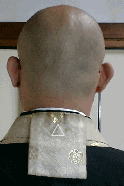Student A: What is the meaning of the design on the maneki?
Suzuki-roshi: Hmm? Yeah?
Student A: Yeah. The design?
Suzuki-roshi: Oh, that is-I don't think that it-that is just to keep, you know, keep two-two parts tied together. It is pine, you know, pine leaf. That is, you know-in Japan, pine symbolize-pine is-pine tree is-is supposed to be-first of all, it is always green, and pine tree lives long long time, and it doesn't change its color all year round. So we have some special feeling about pine, and that pine leaf we use in various way, you know, that design. When you make some-some furoshiki,[a square piece of cloth in Japan used for wrapping items such as gifts] you know, we put pine leaves [on them], you know. I think that is why maybe better to ask Yoshida-roshi [laughs]. He may have some reason-she may have some reason, but I think that is more very common, you know, for Japanese in Japanese culture to use pine leaves. You notice, you know, many-we have many pine-tree design or pine-leaves design. We like bamboo also. Bamboo.
http://suzukiroshi.sfzc.org/archives...emore=y#_ftn12




 Reply With Quote
Reply With Quote
 )
)
















